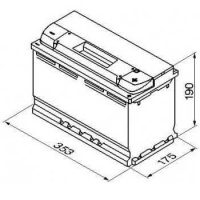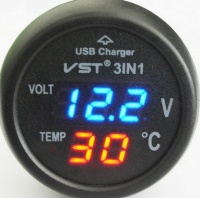Battery: Difference between revisions
(refactor) |
(→Symptoms: added "BATTERY CHARGE VISIT WORKSHOP!" image and link to "faulty alternator" page) |
||
| Line 34: | Line 34: | ||
* A quiescent or parasitic drain usually shows as a flat battery after the vehicle is left standing for a considerable time, such as when the owner is on a vacation. A battery in good condition should last for several months with the vehicle locked and still start reliably at the end of that period. | * A quiescent or parasitic drain usually shows as a flat battery after the vehicle is left standing for a considerable time, such as when the owner is on a vacation. A battery in good condition should last for several months with the vehicle locked and still start reliably at the end of that period. | ||
* A battery at the end of its life will cause the vehicle to be difficult to start and may not crank the engine at all. | * A battery at the end of its life will cause the vehicle to be difficult to start and may not crank the engine at all. | ||
* A [[Alternator#Faulty_Alternator|faulty alternator]] will fail to charge battery and in a very extreme cases will cause a warning message "BATTERY CHARGE VISIT WORKSHOP!" to be displayed in dashboard. | |||
{| | |||
|[[File:W220_Warning_Battery_Charge_Visit_Workshop.jpg|thumb|none|Instrument cluster displaying warning message "BATTERY CHARGE VISIT WORKSHOP!".]] | |||
|} | |||
===Causes=== | ===Causes=== | ||
Revision as of 18:05, 30 July 2016
Back to: Index
Location
The W220 S Class has only one battery (see auxiliary battery page for non-standard secondary battery option).
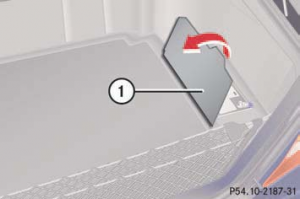 |
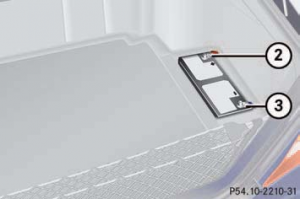 |
The battery is located on the right side of the trunk under the battery cover (1).
The positive (+) terminal is marked (2) and the negative (- or earth or ground) terminal (3) in the next diagram.
Specification
Operators manual specifies 12V 95Ah battery. Dimensions: 353mm/175mm/190mm.
Mercedes-Benz recommends AGM batteries. Good choice is BOSCH S6 013 95Ah 850A battery with AGM-technology (after 2015 the model is denoted by S5 A13).
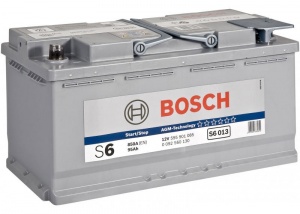 |
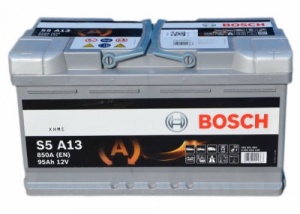 |
Issues
Symptoms
- A battery that is not fully charging will usually cause a Warning on the multi-function display as well as possibly cause some ECUs to malfunction. The vehicle may also be difficult to start or worse, even fail to crank at all. A common symptom is very slow remote control locking or unlocking.
- An over charging battery will possibly cause the alternator to sound very loud and may even smell hot or produce smoke. ECUs may be permanently damaged with constant voltages over 15V.
- A quiescent or parasitic drain usually shows as a flat battery after the vehicle is left standing for a considerable time, such as when the owner is on a vacation. A battery in good condition should last for several months with the vehicle locked and still start reliably at the end of that period.
- A battery at the end of its life will cause the vehicle to be difficult to start and may not crank the engine at all.
- A faulty alternator will fail to charge battery and in a very extreme cases will cause a warning message "BATTERY CHARGE VISIT WORKSHOP!" to be displayed in dashboard.
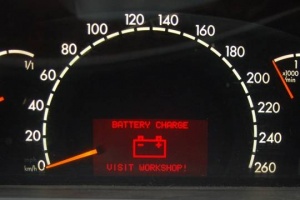 |
Causes
- Battery not charging fully or over charging (see alternator page).
- Parasitic discharge of battery.
- Battery at end of its life.
Battery Tests
There are many battery monitoring tools available such as simple LED indicators showing good mediocre or bad battery state of charge to full electronic high performance Digital volt Meters (DVM), and clip on current measuring meters. One of the latest and most convenient is a three in one device which plugs into the 12V outlet in the cabin, and which shows the battery voltage on a digital display as well as the interior temperature and provides a convenient USB charging outlet.
With the 12V adapter system the battery voltage may be easily monitored during normal driving conditions.
If you are down below 12.4V overnight, your battery is at the end of its life. Continue to use it will cost you a new alternator. W220's take lots of current (amps) to maintain the electrical systems even when you are not using your car.
Checking Parasitic Battery Drain
If you find that the battery is constantly going flat or the unlocking system seems to take a long time to respond, it could be that you have a low voltage battery caused by excessive quiescent current draw. The W220 is particularly prone to large quiescent current draw, often called parasitic current drain through it's proliferation of electronic circuits some of which are constantly activated. Sometimes the electronic circuits can develop issues and become heavy continuous users of battery power. When the car has been locked and has fully gone to sleep (takes at least twenty minutes) the quiescent drain from the car battery must not exceed 0.05A or 50mA.
Follow these steps to test the current draw of locked vehicle:
- 1. Close the trunk lock latch to fool the car into thinking that the trunk is closed.
- 2. Lock the car. If you have keyless-go don't keep receiver close to the car otherwise car might not go to sleep.
- 3. Using a clamp meter that can measure small current (CEM DT-337 is one of such meters) clamp the positive or negative lead of the battery.
- 4. Right after the car is locked, the car can still consume around 0.5A (500mA).
- 5. After twenty minutes the car should fully go into sleep and should consume around 0.05A (50mA). Note that clamp meter is not very precise when measuring very small current, therefore, anything less than 100mA is probably fine.
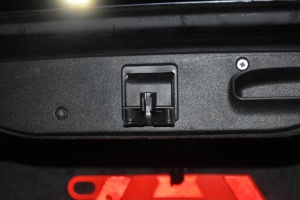 |
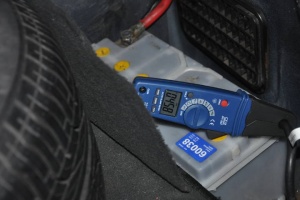 |
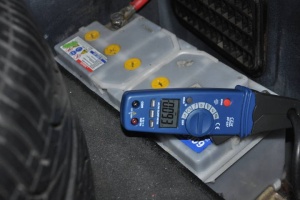 |
If the battery draw does not drop after half an hour, you may try to remove fuse after fuse until the draw drops. Then using fuse charts locate faulty device. Be warned this technique can require a lot of resetting ECUs afterwards.
A common source for parasitic drain is the navigation device which might not go into sleep if the DVD has got stuck or the electronics has failed.
See the DIY guides below for more detailed parasitic drain current tests:
- DIY High Current Sensor - Quiescent Current or Parasitic Discharge Tests Summary: Thorough quiescent current draw can be performed by making a current sensor by manufacturing a very low resistance resistor out of a piece of coat hanger and inserting it into the main battery lead. Then a normal Digital Volt Meter (DVM) can be used to measure the voltage drop across the resistance.
- DIY Voltage Drop Across Fuses - Quiescent Current or Parasitic Discharge Tests Summary: It is also possible to measure the voltage drop across individual fuses using an accurate Digital Volt Mater (DVM) to give an indication of where quiescent current or parasitic current is draining the battery.
- Battery Drain Tutorial
Jump Starting
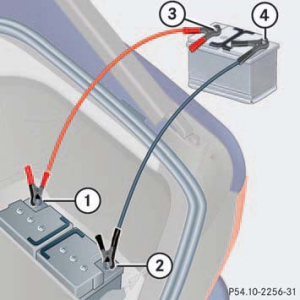
Vacation Charging
Even in sleep mode, W220 has many consumers which can cause W220 battery being discharged in a few weeks. If you are out of town for over a week, you should hook up a charger to the battery and use a timer to kick it on for about one hour daily. It is a good idea to install a charging point inside the engine compartment for easy access while vacation charging or using STAR DAS. (MBs after about 2006 have such charging ports fitted at the factory.)
Charging from Inside the Engine Compartment
- Remove the lid from the Right (Passenger side US, Drivers side UK) fuse box.
- Connect the negative lead from the charger to the earth point just in front of the fuse box (or any good earth).
- Connect the positive lead from the charger to fuse f33, 40A, that one runs air conditioner and blower motor and is constantly live (at 12V).
- It may be too difficult to connect to the terminal on fuse f33, 40A. If so get a spare 40A fuse and solder an extension lug onto one of the terminals. You may need a couple of goes as the heat from the soldering iron tends to melt the plastic. Use a spare so that if you damage permanently it you will not be stranded.
